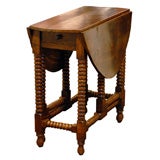19 Th Century Drop Leaf Table
Recent Sales
Antique 19th Century English Drop-leaf and Pembroke Tables
Wood
Antique 19th Century French Side Tables
Wood
19 Th Century Drop Leaf Table For Sale on 1stDibs
How Much is a 19 Th Century Drop Leaf Table?
Finding the Right drop-leaf-tables-pembroke-tables for You
Antique and vintage drop-leaf and Pembroke tables are the perfect solution for those of us in the “space-conscious” category. These furnishings have long been a smart choice for homes, particularly if you’re working with an especially modest house or apartment.
A drop-leaf table is a table with a fixed center section, but on either side of that, there are hinged leaves that can be raised or lowered according to your specific needs.
Should you need to accommodate more guests for a dinner party, a drop-leaf table’s side pieces can be raised and locked into place on their hinges, which will extend the overall surface area of the table. If you’re thinking of serving buffet-style or need a place for dinner plates and other tableware, fold one half of the table down and tuck it against the wall, console-table-style, to make more space for the guests congregating in your dining room. When your dinner companions are ready to retire to the living room for a digestif, both drop leaves can be collapsed if you need a makeshift bar cart or if you prefer to stow away the table after dinner.
The Pembroke version of these tables was a lightweight iteration that is believed to have been named for the ninth Earl of Pembroke or his wife, the countess. It is said that the countess had a drop-leaf table commissioned for their home, specifically for the purposes of serving and eating breakfast. This Georgian-era furniture had an oval or rectangular tabletop, was usually outfitted with a drawer and was frequently made of mahogany. It was a popular furnishing that was made through the Victorian and Edwardian periods.
With its convenient transformative qualities, a drop-leaf table can be put to use in every room of your home. A Pembroke nightstand would render having breakfast from the comfort of your bed easier than ever, while a casual living-room drop-leaf end table can quickly be extended in order to make room for movie-night snacks or a family game. The appeal of these tables doesn’t end at 18th-century nobility or chess enthusiasts, however.
Furniture designers of mid-century modern drop-leaf tables explored various forms and worked with a range of materials in crafting these furnishings and even integrated elements such as wheels for extra convenience. On 1stDibs, find a wide variety of vintage and antique drop-leaf and Pembroke tables that includes sleek and understated iterations crafted by Hans J. Wegner and alluring versions in teak or rosewood designed by Kurt Østervig.
Read More
The Ultimate Guide to Types of Tables for the Home
Whether you’re just moving in or ready to give your home a makeover, our guide will give you pointers on tables that are fitting for every room, nook and hallway.
Riotous Shapes and Colors Have Made Uchronia’s Designs the Toast of Paris
Julien Sebban’s energetic design collective is radically reshaping the look of 21st-century European furniture and interiors.
Is Lionel Jadot the Willy Wonka of Upcycled Belgian Design?
From his massive collaborative workshop in a former paper factory, the designer concocts funky furniture from disused materials, as well as luxe hotel interiors like the new Mix Brussels.
Inspired by the Cosmos, Sandra Nunnerley’s Nova Table Has a Futuristic Feel
The designer’s innovative use of an unexpected material gives this console a lift.
This 19th-Century Gilded Desk Displays a Fanciful Kingdom in Marquetry
The stately piece brings both gravitas and whimsy to any work space.
In Guadalajara, These Luscious Side Tables Are Chiseled from Volcanic Rock
Use them as tables or stools, indoors or out.
How to Arrange Furniture + Layout Ideas
Here, we give design advice and show layout examples to help you create the perfect living room setup.
Why Hollywood A-Listers Can’t Get Enough of James De Wulf’s Concrete Furniture
Starting with a 900-pound Ping-Pong table, the Los Angeles designer has built a sturdy furniture-making career out of concrete.

